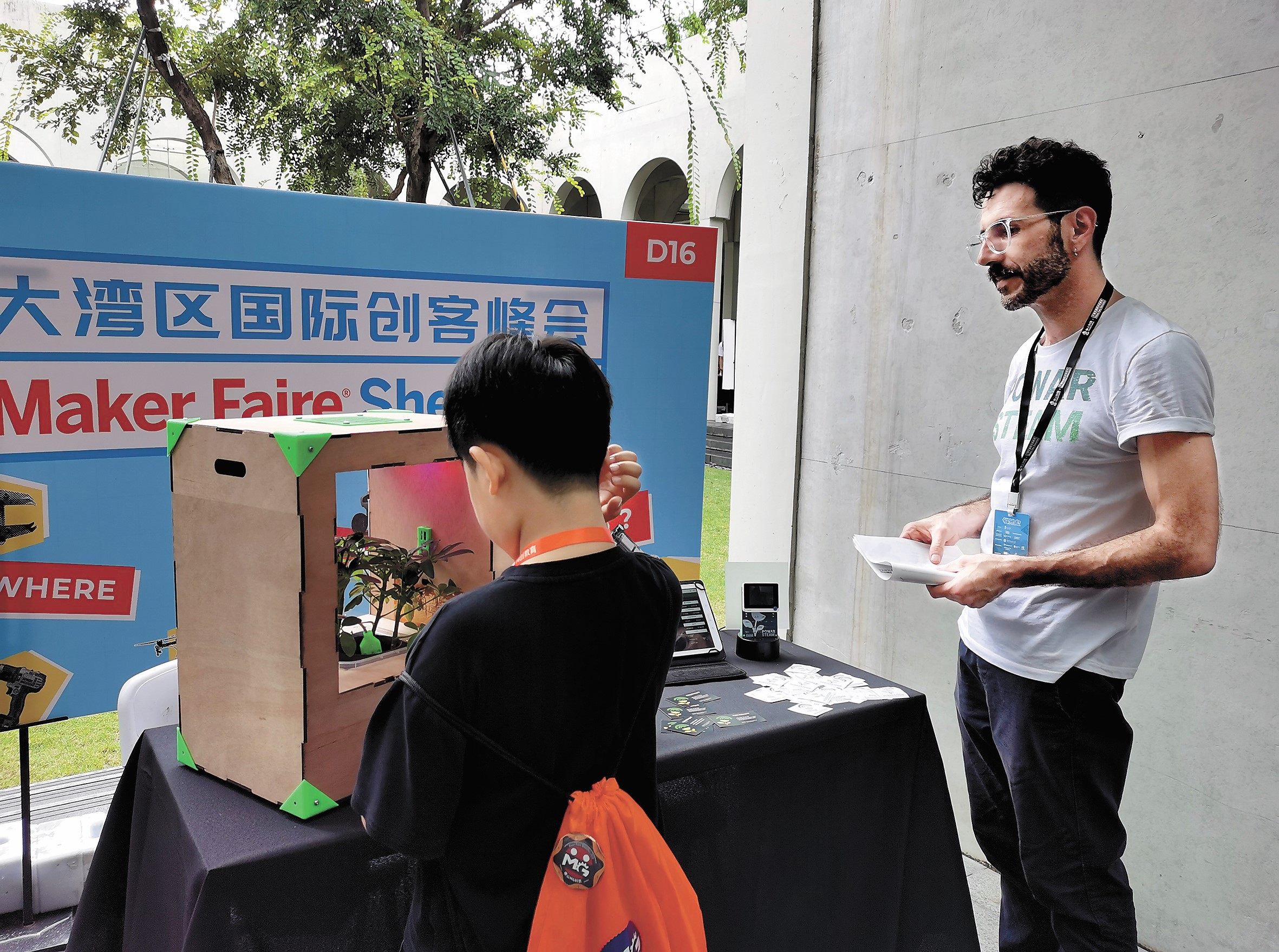Maker Faire SZ 2023 links makers and industries
Source: SWIUpdated: 2023-11-14
Following a three-year hiatus due to the pandemic, Maker Faire Shenzhen made a return on Nov. 11 with a gleeful bazaar of innovations, inspiring talks and hands-on activities, serving as a celebration of maker culture.
Organized by Chaihuo Maker Space, in strategic partnership with Seeed Studio and Make Community, and co-organized by Vanke Cloud City, Maker Faire Shenzhen 2023 attracted more than 120 exhibitors from nearly 30 countries and regions to showcase technologies, foster cooperation and exchange ideas at Design Commune in Nanshan District over the weekend.

Visitors browse products and projects at Maker Faire Shenzhen 2023 at Design Commune in Nanshan District last weekend. Photo courtesy of the organizer
The projects, solutions and products presented at the fair spanned across more than 30 industries, with specific focuses including artificial intelligence (AI), smart manufacturing, education, entertainment, smart cities and smart agriculture.
In addition to the participation of well-known enterprises such as NVIDIA, Raspberry Pi, Bambu Lab and Seeed Studio, more than 10 universities including Shenzhen Polytechnic University, Southern University of Science and Technology, Shenzhen Technology University and Tsinghua Shenzhen International Graduate School also showcased cutting-edge technologies and applications.
Since its inception in 2012, Maker Faire Shenzhen has evolved from displaying contraptions and do-it-yourself (DIY) ingenuity to becoming a platform where technological innovations intersect with various industries. This year, organizations such as Airbus China Innovation Center, Vanke Urban Research of China Vanke and ABeam Consulting were also invited to participate in the fair, fostering cooperation between industries and makers.
“I’m exploring the possibility of connecting with STEAM [science, technology, engineering, arts and mathematics] education companies to distribute my products to schools or government entities through Maker Faire Shenzhen,” Pablo Zuloaga Betancourt, a Spain-based Colombian exhibitor, told Shenzhen Daily at the fair Saturday.

A boy observes the POWAR prototype developed by Pablo Zuloaga Betancourt (R) at Maker Faire Shenzhen 2023 on Nov. 11. Photo by Cao Zhen
He introduced his POWAR prototype at the fair — a low-cost climate simulator designed for research, education and experimentation in plant cultivation under the predited climate conditions of a particular city. The device was developed for environmental education in schools or for smallholder farmers to collect data from their crops.
“Previously, there was a considerable distance between maker companies and traditional manufacturing. But now, through Maker Faire Shenzhen, maker companies such as Switch Science, Seeed Studio, M5Stack and some 3D-printing companies are working closely together. This year, we’ve also seen many universities at the fair. This integration is a good thing,” Japanese engineer and maker-culture advocate Masakazu Takasu told Shenzhen Daily on Saturday.
Takasu moved to Shenzhen in 2018. His company, Switch Science, distributes open-source hardware tools and components, partnering with startups and communities in Shenzhen. He has attended hundreds of Maker Faire events across the globe since 2014.
“After the pandemic, I’ve been to Maker Faire events in Shanghai, Tokyo and the U.S. Bay Area this year. Shenzhen possesses a vibrant ecosystem for industries, DIY projects and emerging startups, distinguishing Shenzhen’s Maker Faire from those held in other cities,” he added.

A girl tries to touch the smoke projected from an air cannon at Maker Faire Shenzhen 2023 on Nov. 11. Photo by Cao Zhen
Under the theme “Where Are the Makers?,” the two-day fair also included forums, workshops and a range of activities. More than 30 speakers from home and abroad discussed various topics at the forums. In the “Through the Cycles” session, speakers such as Eric Pan (founder and CEO of Seeed Studio), Eben Upton (CEO of Raspberry Pi) and David James Groom (community editor of Make Community) shared their insights on the trends in the maker movement, and explored the vast potential and opportunities for future pathways.
“Thanks to makers’ cross-disciplinary capabilities, makers can serve as the linchpin for digital transformation across various sectors in industries,” said Pan.
The “Tech for Good” session also explored the influential role of makers in advancing the sustainable development of multiple industries within the realm of industrial digitization.
The “Cyber Farm” session featured insights and cases from experts from technology firms and organizations, highlighting digital technology’s contributions in agricultural and rural development. The speakers shared the applications and future prospects of agricultural sensors, intelligent equipment, data modeling algorithms, meteorological index insurance, and segmented crop industry services.
The “Things w/AI” session assembled experts from scientific research institutes and investment firms to examine open innovation ecology, generative AI, and the current and future applications of AI technology in the hardware sector.
Throughout the fair, nearly 40 workshops provided immersive hands-on experiences for participants to learn about technological innovations in wearables, 3D printing, robots and more. Workshops for professionals covered such topics as advanced perception systems, tinyML, agricultural technology and visual AI.
 Copyright © Shenzhen Nanshan Information Network Center. All rights reserved.
Copyright © Shenzhen Nanshan Information Network Center. All rights reserved.



